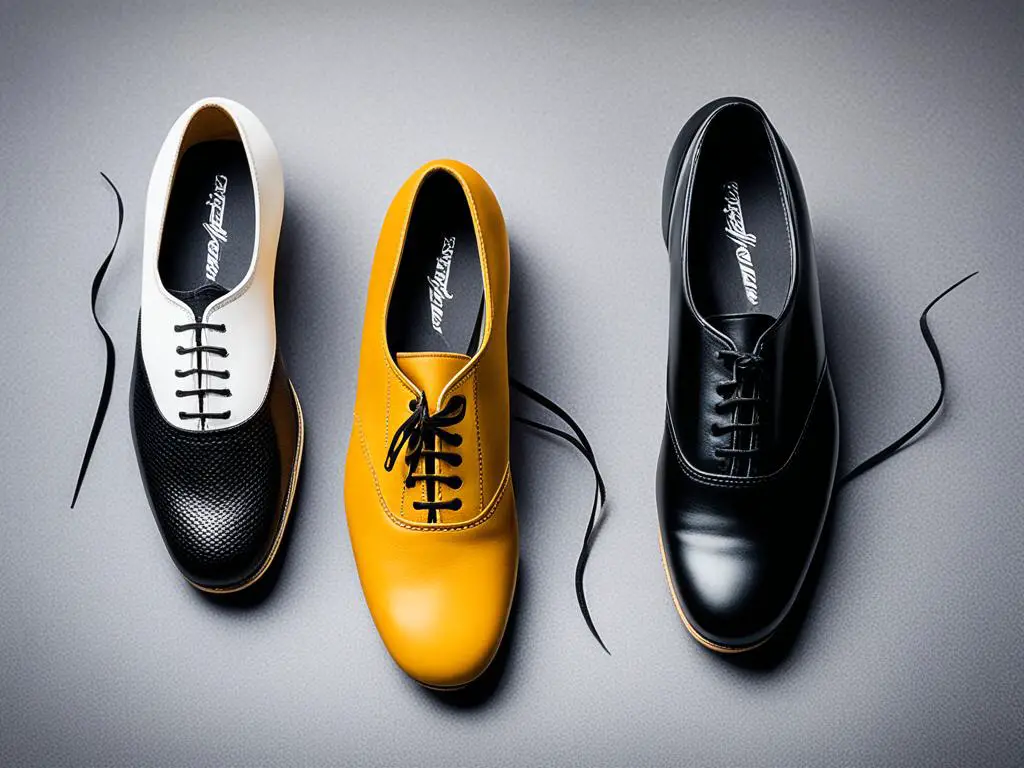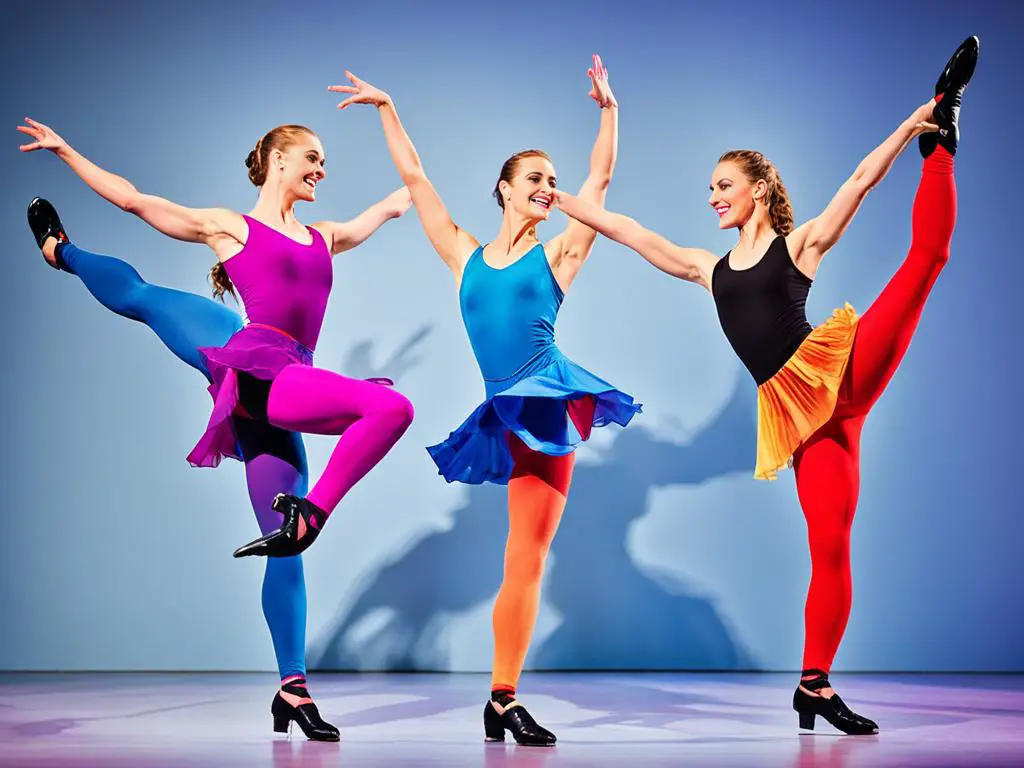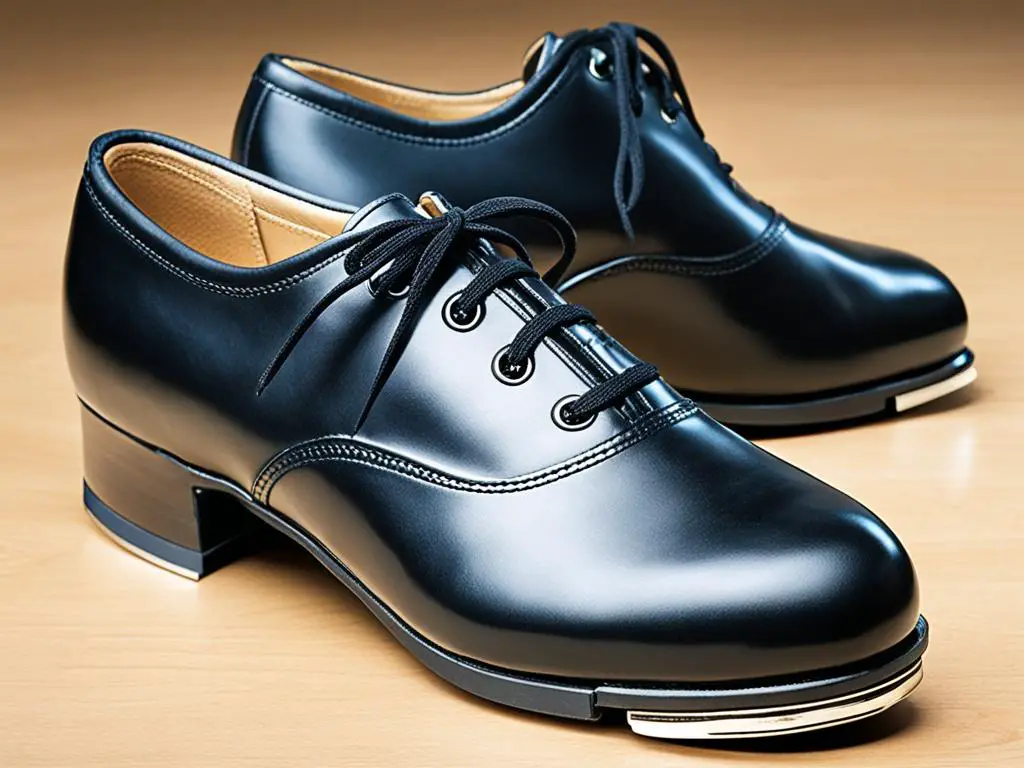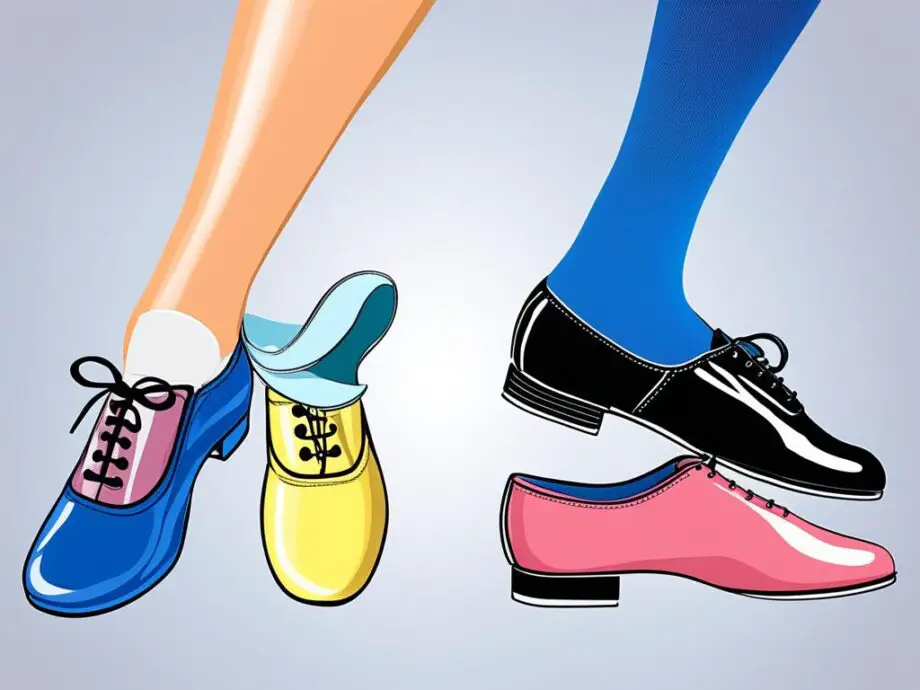Are you a tap dancer looking to invest in a new pair of tap shoes? If so, you might find yourself faced with the choice between split sole tap shoes and full sole tap shoes. While both options have their benefits, it’s important to understand the differences between them and choose the one that best suits your dance style and preferences.
Key Takeaways:
- Split sole tap shoes and full sole tap shoes have distinct characteristics and advantages.
- Split sole tap shoes offer enhanced flexibility and natural foot movement, perfect for intricate footwork.
- Full sole tap shoes provide stability and support for beginners and powerful moves.
- Your dance style and preferences should guide your decision when choosing between split sole and full sole tap shoes.
- Consider the specific requirements of your routines to select the tap shoes that best suit your needs.
Understanding Tap Shoe Soles
Before we delve into the specifics, let’s first understand the concept of tap shoe soles. Split sole tap shoes have a sole that is divided into two parts, while full sole tap shoes have a single continuous sole. These soles play a crucial role in the flexibility, support, and performance of tap shoes.
Split sole tap shoes, as the name suggests, have a split or separated sole. This design allows for greater flexibility and articulation of the foot, particularly in the arch area. It allows dancers to move their feet more freely, delivering intricate footwork with precision.
On the other hand, full sole tap shoes feature a solid, unbroken sole that extends from the toe to the heel. This design offers excellent support and stability, making it suitable for beginners or dancers who require more support during their routines. The continuous sole provides a consistent surface for tapping and helps maintain balance while performing.
Both split sole and full sole tap shoes have their unique advantages and appeal to different dancers based on their dance style, preference for flexibility or support, and individual comfort levels. Now, let’s take a closer look at some of the characteristics and benefits of each type.

Benefits of Split Sole Tap Shoes
Split sole tap shoes offer several advantages for dancers. The unique design of split soles enhances flexibility and allows for a greater range of motion, especially in the arches of the feet. This increased flexibility enables dancers to execute intricate footwork with precision and ease.
With split sole tap shoes, dancers experience a more natural foot movement. The division in the sole of the shoe allows for better articulation, allowing dancers to showcase their skills and express their style more effectively.
“Split sole tap shoes provide dancers with the freedom and flexibility to showcase their full potential. The enhanced range of motion allows for more intricate footwork while maintaining a natural and comfortable feel.”
The split sole design also offers improved arch support, allowing dancers to maintain proper foot alignment and reducing the risk of fatigue or strain during performances. This additional support contributes to overall foot health and comfort, enhancing the dancing experience.
Furthermore, the flexibility of split sole tap shoes enables dancers to adapt and adjust their movements quickly. This flexibility is particularly beneficial for dancers who engage in various dance styles and techniques, as it allows for seamless transitions between different routines.
Overall, the benefits of split sole tap shoes, including enhanced flexibility, natural foot movement, improved arch support, and quick adaptability, make them a popular choice among dancers looking to elevate their performances.

Characteristics of Full Sole Tap Shoes
Full sole tap shoes are a popular choice among beginners or dancers who seek additional support during their routines. These shoes feature a single continuous sole that offers stability and distributes weight evenly across the entire foot.
The solid sole surface of full sole tap shoes provides a consistent platform for tapping, ensuring clear and crisp sounds during performances. The stability they offer is particularly beneficial for beginners who are still developing their balance and coordination skills.
One of the key characteristics of full sole tap shoes is their ability to support the feet throughout various dance movements. The solid sole design helps promote proper alignment and reduce strain on the feet and ankles, making them suitable for dancers who prioritize stability and support over flexibility.
Advantages of Full Sole Tap Shoes:
- Stability and balance: The continuous sole provides a stable base for dancers, enhancing balance and control.
- Support: Full sole tap shoes offer reliable support throughout the foot, reducing the risk of discomfort or injuries.
- Consistent sound: The solid sole surface ensures consistent and clear tap sounds, enhancing the overall performance.
“Full sole tap shoes provide stability, support, and a solid surface for dancers to confidently express themselves through tap rhythms.” – Mary Johnson, professional tap dancer
While full sole tap shoes excel in stability and support, their sole design may limit flexibility compared to split sole tap shoes. However, this trade-off is often preferred by dancers who are focused on powerful moves and intricate footwork.
Full Sole Tap Shoes Characteristics Comparison
| Characteristics | Full Sole Tap Shoes | Split Sole Tap Shoes |
|---|---|---|
| Flexibility | Less flexible due to the continuous sole | More flexible with divided sole design |
| Support | Offer excellent support for stability | Provide moderate support while emphasizing flexibility |
| Sound Quality | Consistent and clear sound during tapping | Sound quality may vary based on individual footwork |
| Recommended for | Beginners and those seeking more support | Dancers focusing on flexibility and intricate footwork |
Overall, the characteristics of full sole tap shoes make them an ideal choice for beginners or dancers who prioritize stability and support over maximum flexibility. Selecting the right tap shoes ultimately depends on your dancing style, preferences, and individual comfort.

Flexibility and Performance Comparison
When it comes to tap shoes, the flexibility and performance they offer are essential factors to consider. Let’s take a closer look at how split sole tap shoes and full sole tap shoes compare in terms of flexibility, support, and overall performance.
Flexibility
Split sole tap shoes take the lead when it comes to flexibility. The divided sole design allows for greater articulation of the foot, providing dancers with a wider range of motion. This increased flexibility is particularly beneficial for executing intricate movements and footwork with precision and control.
Full sole tap shoes, on the other hand, offer a solid base that provides stability and support. While they may not offer the same level of flexibility as split sole tap shoes, the continuous sole design ensures a consistent surface for tapping and enhances balance during powerful moves and jumps.
Performance
Considering performance, the choice between split sole and full sole tap shoes largely depends on the dance style and personal preference.
“Split sole tap shoes allow for more intricate footwork and better control over movements. On the other hand, full sole tap shoes provide stability and support for powerful and dynamic performances. It’s crucial to find the right balance between flexibility and stability based on individual needs.”
In summary, split sole tap shoes excel in flexibility, granting dancers greater control and articulation of their footwork. On the other hand, full sole tap shoes offer stability and support, facilitating powerful and impactful movements. The choice ultimately comes down to your dance style and the specific requirements of your routines.
| Flexibility | Support | Performance | |
|---|---|---|---|
| Split Sole Tap Shoes | ✅ | ❌ | ✅ |
| Full Sole Tap Shoes | ❌ | ✅ | ✅ |
Choosing the Right Tap Shoes for Beginners
When starting out in tap dancing, it’s essential to have the right shoes that provide the necessary support and stability for beginners. One popular option for beginners is full sole tap shoes.
Full sole tap shoes are designed with a continuous sole that extends from the toe to the heel, offering extra support and cushioning for beginners. This design helps build strength in the feet and legs, providing a solid foundation for learning tap dance techniques.
One of the main advantages of full sole tap shoes for beginners is the improved balance they offer. The continuous sole allows for better weight distribution, helping new dancers maintain stability while executing footwork and movements.
Another benefit of full sole tap shoes is that they promote proper alignment of the feet and ankles. The solid sole helps beginners develop the correct foot positioning and alignment, which is crucial for executing tap steps accurately.
It’s important to note that the choice between full sole and split sole tap shoes depends on personal preference. Some beginners may find that split sole tap shoes provide a greater range of motion, while others may prefer the stability and support offered by full sole tap shoes.
“As a beginner in tap, full sole tap shoes provided me with the support and stability I needed to feel confident in my dance practice. The continuous sole helped me focus on learning the basics and building a strong foundation for my tap skills.” – Amy, beginner tap dancer
Ultimately, finding the best tap shoes for beginners is about comfort and suitability for individual dancers. It’s recommended to try on both split sole and full sole tap shoes to see which style feels more comfortable and supportive.
Remember, as you progress and gain more experience in tap dancing, your preferences may change. It’s always important to choose tap shoes that align with your current skill level and dance goals.
Comparison of Full Sole and Split Sole Tap Shoes for Beginners
| Criteria | Full Sole Tap Shoes | Split Sole Tap Shoes |
|---|---|---|
| Support | High | Moderate |
| Flexibility | Low | High |
| Balance | Excellent | Good |
| Range of Motion | Restricted | Wide |
| Recommended for: | Beginners, dancers needing more support and stability | Dancers requiring increased flexibility and range of motion |
Considering Your Dance Style
Your dance style plays a significant role in choosing between tap shoes with split sole vs full sole. It’s essential to align your footwear with the specific demands of your routine to enhance your performance and overall comfort.
If you excel in intricate footwork and require ultimate flexibility, split sole tap shoes may be the better option. The divided sole allows for greater articulation of the foot, providing a higher level of control for precise movements. This flexibility allows you to execute complex steps with ease, ensuring a seamless and polished performance.
On the other hand, if your dance routine is more focused on powerful moves and you require stability for jumps and landings, full sole tap shoes may be more suitable. The continuous sole offers a solid base, reinforcing your balance and providing the necessary support for dynamic and impactful movements.
Remember, your tap shoes are an extension of your body when you dance. They should complement your style and enable you to express yourself fully. Understanding the unique attributes of split sole and full sole tap shoes will guide you in making an informed decision tailored to your dance style.
Tap Shoes with Split Sole vs Full Sole: A Comparison
| Tap Shoe Type | Flexibility | Support | Performance |
|---|---|---|---|
| Split Sole | Offers enhanced flexibility, allowing for a greater range of motion | Provides a natural foot movement, facilitating intricate footwork | Ideal for executing precise and intricate steps with ease |
| Full Sole | Offers stability and support throughout the entire foot | Provides a solid base for power moves and jumps | Ensures balance and impactful movements |
By comparing the flexibility, support, and overall performance of tap shoes with split sole vs full sole, you can determine which type aligns best with your dance style and objectives. Keep in mind that personal preference and comfort also play a vital role in selecting the right tap shoes.
Conclusion
After exploring the differences between split sole and full sole tap shoes, it is clear that each type has its own advantages. The choice between them ultimately depends on your dance style, preference for flexibility or support, and individual comfort.
If you are a dancer who performs intricate footwork and requires ultimate flexibility, split sole tap shoes are the way to go. The divided sole allows for greater articulation of the foot and better control over intricate movements. These shoes are ideal for dancers who prioritize intricate footwork and a greater range of motion, particularly in the arches of the feet.
On the other hand, if you focus more on power moves and require stability, full sole tap shoes may be more suitable. The single continuous sole offers stability and support throughout the entire foot, providing a solid base for powerful moves and jumps. Full sole tap shoes are often preferred by beginners or those who require more support during their dance routines.
Ultimately, it is important to consider the specific requirements of your routines when selecting tap shoes. Take into account your dance style, the level of flexibility or support you need, and your individual comfort. By doing so, you can choose the tap shoes that best suit your needs and enhance your performance on stage.
